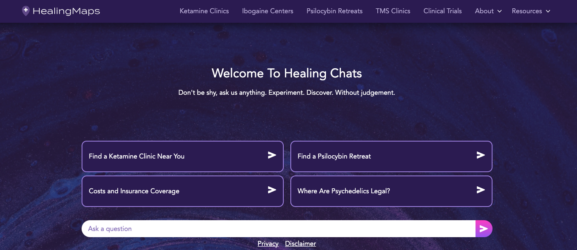Soma-Delics: What Potential do Psychedelics Have to Treat the Body?
As excitement over the potential of psychedelic therapy to heal the mind looms large, there is also a growing body of research that points towards the potential of psychedelics to also heal the body—and with good reason. The mind body healing connection (also called somatic therapy) is gaining popularity in the psychedelic industry, and for good reason.
It makes sense. Part of the power of psychedelics lies within its ability to forge new pathways in the mind and allow for new lines of neurological communication. It stands to reason, then, that some of those same new pathways could also address physical ailments.
The practice isn’t entirely new. For example, Amazonians have used ayahuasca to treat stomach aches, in addition to afflictions of the mind. Today, research has shown that ayahuasca could potentially treat chronic inflammation and oxidative stress.
Anecdotally, there have been reports of psilocybin helping someone learn to walk after paralysis or of LSD curing allergies.
But there are plenty of studies to look forward to as well. Researchers are looking into the use of psychedelics to treat stroke and traumatic brain injury, autoimmune diseases, and chronic pain.
With that in mind, we’re talking to psychedelic practitioners from around the globe to learn how they’ve used psychedelics in their treatment centers and what potential they have to treat the physical body as well as the mind. Here’s what they had to say.
Dr. Jennifer Ellice – Golden Afternoon
I think most of us who practice modern western medicine understand at this point that there isn’t really a “mind/body” dichotomy, and that the distinction between the mind and the body can often be unhelpful. Especially for my patients with chronic pain, who are tired of hearing that their pain “isn’t real” or is “all in the mind,” the distinction between the two is especially problematic and it can feel like medical gaslighting to hear that from a doctor. For these patients, the pain is very much real, and it often affects every aspect of their lives. Their pain pathways are stuck in an unhealthy pattern, one that may not actually reflect true tissue damage or injury, but which continuously signal as if there were ongoing injury. Psychedelics, like ketamine, can be useful tool to break preexisting patterns or habits, whether those habits be emotional, addiction or pain related.
One fascinating phenomenon that I’ve witnessed is an experience that I call the “mind scan.” This phenomenon can happen during an IV ketamine infusion session, or sometimes afterwards, when a person is relaxing, meditating or falling asleep, even days after a treatment. Patients have described a sensation that their brain is “scanning” through their body and almost conducting an inventory of sorts, or a recalibration. They’ll say something like, “I felt my consciousness moving through each part of my physical body and checking everything” or “I felt my brain going through all my body parts” and then they’ll describe a sort of semiconscious realization like, “my back isn’t really injured” or “I actually don’t enjoy drinking that much” or that “my chronic knee pain just went away after the scan.” What I find fascinating is that this “mind scan” isn’t something that patients are trying to do consciously, but that it can sort of happen spontaneously. It will even sometimes occur for patients who are receiving treatment for mood disorders, who weren’t focusing at all on their physical body or physical ailments, who maybe didn’t even mention that they had chronic pain; and for them, the relief comes as a kind of surprise bonus. I don’t really have a great scientific explanation for what’s occurring there, but I’ve heard it so many times now, that I think it’s a legitimate part of the healing process. And from what we understand about how ketamine helps to rearchitect the neural pathways involved in opioid dependence and chronic pain, it makes sense that a recalibration must be part of the process of neuroplasticity.
For my patients that want to approach their treatment in that way, and especially for those that are trying to kick a bad habit, I generally encourage them to use the critical window neuroplasticity of their initial treatment series to actively pick up new habits, like learning a new sport or engaging with a hobby that they might have been interested in exploring. Since we know that it’s often easier to replace an unhealthy habit with a healthier one, rather than to try to just extinguish a bad habit, it makes sense that our minds would be better able to make that change while we are undergoing that period of neuroplasticity. And in general, there are some studies to support this concept of steering one’s neuroplasticity in a positive direction following ketamine therapy. Because of this, I strongly encourage all of my patients to make a concerted effort to engage in healthy habits like exercise, journaling, eating well and practicing self compassion during their treatment course.
— Dr. Jennifer Ellice, MD, Chief Medical Officer of Golden Afternoon
Dr. Mike Cooper – Innerwell At-Home Ketamine Therapy
At Innerwell, we prescribe ketamine to treat various psychiatric conditions off-label. Even though psychiatric conditions are the primary indication for our treatment programs, we often hear from patients that their comorbid pain syndromes improve secondarily while undergoing ketamine treatment. One of our patients has a TBI with pain and muscle spasticity from a car accident, and reports that their muscles feel less stiff and they’re in less pain following their ketamine treatment sessions in addition to being in a better mood. Another one of our patients who has chronic back pain from cancer, has been able to reduce the amount of opioids they’re taking as ketamine has provided secondary relief of their pain in addition to alleviating their depression.
— Dr. Mike Cooper, Medical Director of Innerwell At-Home Ketamine Therapy
Kevin Bourke – One Retreats Jamaica
Psilocybin’s potential in enhancing physical rehabilitation and body wellness is an intriguing area of study. Its influence on serotonin receptors suggests a possible role in motor skill improvement, aiding recovery from injuries and neurological conditions. Furthermore, preliminary research hints at its capacity to facilitate neuroplastic changes, crucial for relearning motor skills.
This natural compound shows promise in fostering diverse aspects of physical wellness. For instance, a study published in the Journal of Psychopharmacology (2019) revealed that psilocybin positively impacted motor coordination in mice, indicating its potential for improving motor skills in rehabilitation.
Neuroplasticity plays a vital role in relearning motor skills, facilitating recovery from injuries, and enhancing overall body wellness. Psilocybin’s influence on neuroplasticity may offer new avenues for addressing conditions affecting physical abilities.
Exploring the connection between psilocybin and physical rehabilitation is essential, considering its possible contributions to enhancing body wellness. However, it’s imperative to conduct comprehensive research to understand its safety, efficacy, and broader implications for human motor skill rehabilitation before widespread implementation in therapeutic settings.
— Kevin Bourke, Co-Founder of ONE Psilocybin Retreats JAMAICA
Dr. James Simonson – Integrative Psychiatry of Oklahoma
Let me tell you the story of C, a patient who found newfound hope through ketamine treatment. C had been living with severe trigeminal neuralgia, a condition that arose as a complication following a dental procedure. Her life was dominated by relentless, excruciating chronic pain that left her feeling trapped and overwhelmed. She sought help and was introduced to ketamine infusions as part of her treatment plan.
During her ketamine infusions, C underwent a transformation that was nothing short of remarkable. The ketamine effectively alleviated her pain, allowing her to experience moments of relief for the first time in a long while. What made this experience even more profound was her ability to actively engage in jaw range of motion exercises while the ketamine took effect. These exercises were a crucial part of her rehabilitation process, and the relief provided by ketamine allowed her to participate in therapy even in the midst of her infusion.
What truly set her journey apart was her experience during these infusions. While receiving the ketamine treatment, C found herself in a unique mental state that allowed her to reframe her relationship with pain. Instead of it being a constant, oppressive force in her life, the pain became something she could approach and work with, rather than escape from. The ketamine-infused moments gave her a perspective shift, allowing her to regain control over her life and her emotional well-being. What truly distinguishes C’s journey is not only the relief from pain but also her newfound ability to return to the activities she had lost during her battle with chronic pain. She rekindled her passion for life and the physical activities she once enjoyed. Additionally, the ability to engage in rehabilitation exercises during ketamine infusions contributed to her rapid progress after a dental procedure complication had initially left her in despair. C’s experience is a testament to the potential of ketamine as a transformative therapeutic tool, offering a path to recovery and a return to an active and fulfilling lifestyle for individuals dealing with chronic pain and its debilitating effects.
— Dr. James Simonson, MD, Owner and Founder of Integrative Psychiatry of Oklahoma
SJ Struckmeyer – Ballen Medical and Wellness
At our integrative psychiatry center, I work with a fair share of clients struggling with depression, brain fog and cognitive issues stemming from lingering concussion symptoms and mild traumatic brain injuries (mBTI). I’m really intrigued by psilocybin’s potential in these cases. We know it alleviates depression, but evidence also suggests it could improve cognition by reducing brain inflammation and promoting neural plasticity. While more human trials are needed, compelling animal studies make me optimistic that psychedelics may offer new hope for recovering brain function after neurological trauma.
— SJ Struckmeyer, MS, CNM, WHNP-BC, Integrative Nurse Practitioner at Ballen Medical and Wellness
Healing Potential of Psychedelics
While more studies are needed, the potential of psychedelics to treat the body, as well as the mind, is promising. There’s a growing body of research that supports what many clinicians and patients already knew—that the body and mind aren’t two separate entities but one and the same.
That said, research into psychedelics is still limited, even more so with their capacity to treat physical ailments. Many questions still remain as to which conditions they can potentially treat, what dosages are appropriate, and much more.
Fortunately, patients seeking treatment for chronic pain or other physical ailments can still find many treatment options both in their area and at retreats abroad. The first step in seeking psychedelic therapy is reaching out to a reputable treatment center who will help you determine if psychedelic treatment is right for you.



